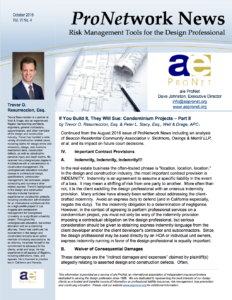 Do architects owe a “duty of care” to the homeowners of a condominium project with whom the architects have no contractual privity? According to the California Supreme Court, they do. What does this mean in practical terms? The answer is that architects are now more than ever exposed to potential future claims and lawsuits brought by homeowners and the homeowners’ associations years after the project has been completed even where the architect’s design decisions are trumped by those of the project developer, and the architect’s role in the construction phase of the project is limited.
Do architects owe a “duty of care” to the homeowners of a condominium project with whom the architects have no contractual privity? According to the California Supreme Court, they do. What does this mean in practical terms? The answer is that architects are now more than ever exposed to potential future claims and lawsuits brought by homeowners and the homeowners’ associations years after the project has been completed even where the architect’s design decisions are trumped by those of the project developer, and the architect’s role in the construction phase of the project is limited.
The purpose of this paper is to provide background on an architect’s potential liability to its client and third parties on condominium projects as well as guidance on how to prospectively address the concerns highlighted by a recent California Supreme Court decision and many other lawsuits in which architects have been sued by third parties. Specifically, we address the following topics: assessing your owner client, important contract provisions, and insurance issues. The intent is to provide a roadmap for architects in assessing their risks on condominium projects and a practical approach to addressing those risks. While it may not be possible to fully insulate architects from all risks, it is certainly a good practice to have a firm understanding of those risks and to address the risks up front. Benjamin Franklin is attributed with the statement: “In this world nothing can be said to be certain, except death and taxes.” For architects who design condominium projects, unfortunately, lawsuits should be added to that list. Continue reading “If You Build It, They Will Sue: Condominium Projects – Part I”





 We’ve posted several times about the confusion surrounding so-called “standard contracts,” as well as the most commonly misunderstood clauses in design professional contracts. When reviewing a new contract for the first time, it can be helpful to know what sound contract language looks like. In February, we published an issue of ProNetwork News titled
We’ve posted several times about the confusion surrounding so-called “standard contracts,” as well as the most commonly misunderstood clauses in design professional contracts. When reviewing a new contract for the first time, it can be helpful to know what sound contract language looks like. In February, we published an issue of ProNetwork News titled 



